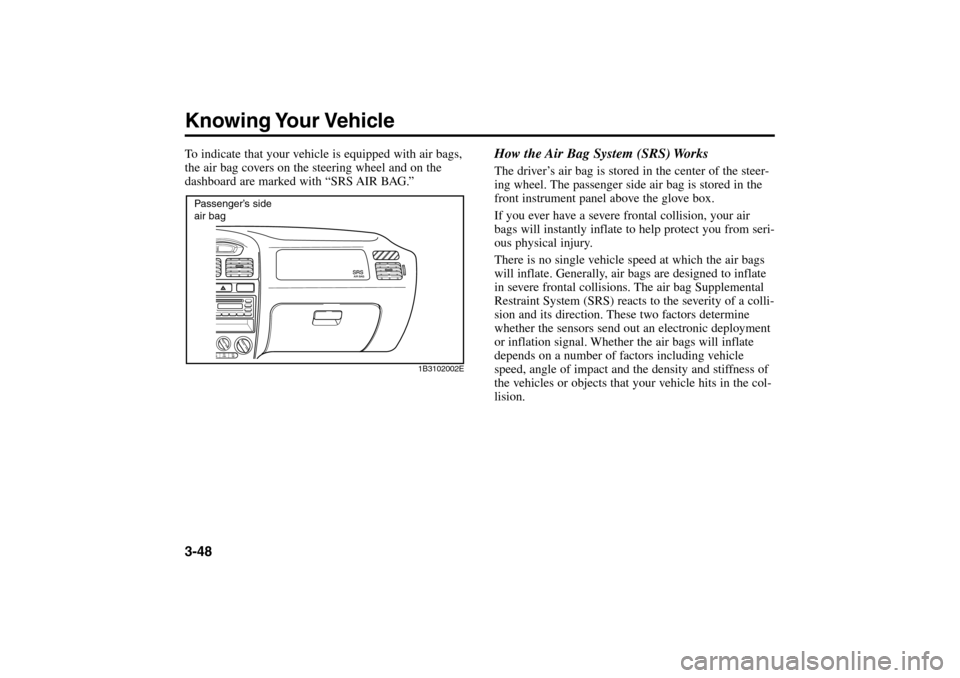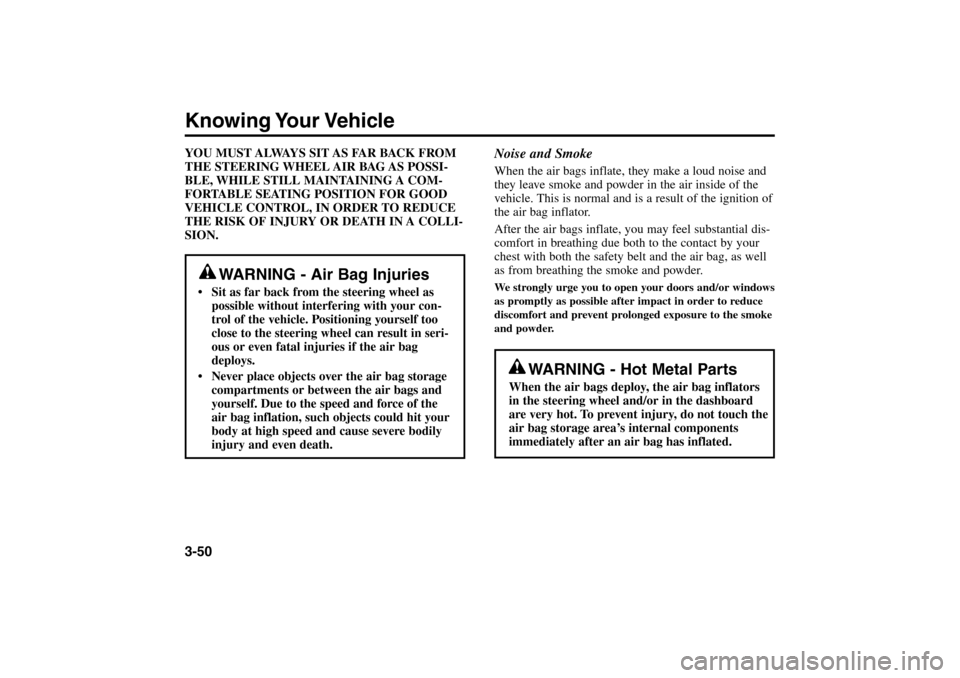dashboard KIA Rio 2005 2.G Owner's Manual
[x] Cancel search | Manufacturer: KIA, Model Year: 2005, Model line: Rio, Model: KIA Rio 2005 2.GPages: 238, PDF Size: 2.6 MB
Page 57 of 238

3-47
(Continued)
Always wear your safety belt. It can help
keep you away from the air bags during
heavy braking just before a collision.
Air bags are designed to inflate only in
severe frontal collisions and will generally
not provide protection in side or rear
impacts, rollovers or less severe frontal colli-
sions. They will also not provide protection
from later impacts in a multi-impact colli-
sion.
If your vehicle has been subjected to flood
conditions (e.g. soaked carpeting/standing
water on the floor of the vehicle, etc.) or if
your vehicle has become flood damaged in
any way, do not attempt to start the vehicle
or put the key in the ignition before discon-
necting the battery. This may cause air bag
deployment, which could result in serious
personal injury or death. Have the vehicle
towed to an authorized Kia dealer for
inspection and necessary repairs.
Air Bag System ComponentsThe main components of your vehicle’s SRS are:
One air bag in the steering wheel for the driver, and
another in the dashboard for the front passenger.
A diagnostic system that continually monitors sys-
tem operation.
An indicator light to warn you of a possible problem
with the system.
Emergency power backup in case your car’s electri-
cal system is disconnected in a crash.
1B3102002E
Driver’s side
air bag
RIO ENG CNA 3.qxd 7/29/05 5:13 PM Page 47
Page 58 of 238

To indicate that your vehicle is equipped with air bags,
the air bag covers on the steering wheel and on the
dashboard are marked with “SRS AIR BAG.”Knowing Your Vehicle3-48How the Air Bag System (SRS) Works
The driver’s air bag is stored in the center of the steer-
ing wheel. The passenger side air bag is stored in the
front instrument panel above the glove box.
If you ever have a severe frontal collision, your air
bags will instantly inflate to help protect you from seri-
ous physical injury.
There is no single vehicle speed at which the air bags
will inflate. Generally, air bags are designed to inflate
in severe frontal collisions. The air bag Supplemental
Restraint System (SRS) reacts to the severity of a colli-
sion and its direction. These two factors determine
whether the sensors send out an electronic deployment
or inflation signal. Whether the air bags will inflate
depends on a number of factors including vehicle
speed, angle of impact and the density and stiffness of
the vehicles or objects that your vehicle hits in the col-
lision.
1B3102002E
Passenger’s side
air bag
RIO ENG CNA 3.qxd 7/29/05 5:13 PM Page 48
Page 60 of 238

Knowing Your Vehicle3-50YOU MUST ALWAYS SIT AS FAR BACK FROM
THE STEERING WHEEL AIR BAG AS POSSI-
BLE, WHILE STILL MAINTAINING A COM-
FORTABLE SEATING POSITION FOR GOOD
VEHICLE CONTROL, IN ORDER TO REDUCE
THE RISK OF INJURY OR DEATH IN A COLLI-
SION.
WARNING - Air Bag Injuries
Sit as far back from the steering wheel as
possible without interfering with your con-
trol of the vehicle. Positioning yourself too
close to the steering wheel can result in seri-
ous or even fatal injuries if the air bag
deploys.
Never place objects over the air bag storage
compartments or between the air bags and
yourself. Due to the speed and force of the
air bag inflation, such objects could hit your
body at high speed and cause severe bodily
injury and even death.
Noise and SmokeWhen the air bags inflate, they make a loud noise and
they leave smoke and powder in the air inside of the
vehicle. This is normal and is a result of the ignition of
the air bag inflator.
After the air bags inflate, you may feel substantial dis-
comfort in breathing due both to the contact by your
chest with both the safety belt and the air bag, as well
as from breathing the smoke and powder. We strongly urge you to open your doors and/or windows
as promptly as possible after impact in order to reduce
discomfort and prevent prolonged exposure to the smoke
and powder.
WARNING - Hot Metal Parts
When the air bags deploy, the air bag inflators
in the steering wheel and/or in the dashboard
are very hot. To prevent injury, do not touch the
air bag storage area’s internal components
immediately after an air bag has inflated.
RIO ENG CNA 3.qxd 7/29/05 5:13 PM Page 50
Page 224 of 238

Maintenance7-52
Interior CareInterior General PrecautionsPrevent caustic solutions such as perfume and cosmetic
oil from contacting the dashboard; they may cause
damage or discoloration. If they do contact the
dashboard, wipe them off immediately.
Upholstery and Interior Trim Cleaning
Vinyl
First, remove dust and loose dirt from vinyl with a
whisk broom or vacuum cleaner. Then, clean vinyl
surfaces with a vinyl cleaner.
Fabric
First, remove dust and loose dirt from fabric with a
whisk broom or vacuum cleaner. Then, clean with a
mild soap solution recommended for upholstery or
carpets. Remove fresh spots immediately with a fabric
spot cleaner. If a fresh spot do not receive immediate
attention, the fabric may be stained and its color can be
affected. Also, its fire-resistant properties may be
reduced if the material is not properly maintained.
Aluminum Wheel MaintenanceThe aluminum wheels are coated with a clear
protective finish.
Do not use any abrasive cleaner, polishing
compound, solvent, or wire brushes on aluminum
wheels. They may scratch or damage the finish.
Use only a mild soap or neutral detergent, and rinse
thoroughly with water. Also, be sure to clean the
wheels after driving on salted roads. This helps
prevent corrosion.
Avoid washing the wheels with high-speed car wash
brushes.
CAUTION
After washing the vehicle, test the brakes while
driving slowly to see if they have been affected
by water.
RIO ENG CNA 7-2.qxd 7/29/05 5:18 PM Page 52